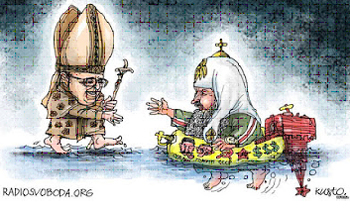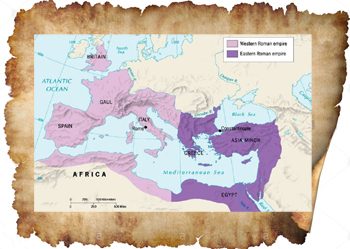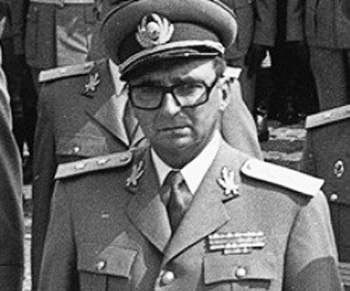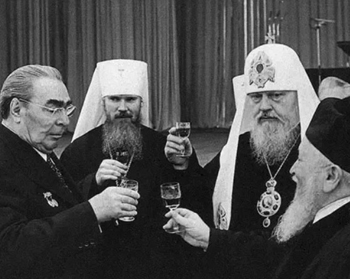Theology of History
 |
 |
 |
 |
 |
 |
 |
The ‘Orthodox’ Masquerade - I
The Church of ‘Patriarch’ Kirill Unveiled
Given the misinformation found on media and social networks, it seems opportune to me to demystify the masquerade of the so-called Russian Orthodox Church. This fraud was generated in the times of communist dictator Joseph Stalin and continues to be spread by the minions of Vladimir Putin and with the approval of Pope Francis. It is also pertinent to remind the reader of the persecutions suffered by the Catholic Church in Ukraine.
 In his book The Martyrdom of the Catholic Church in Ukraine Fr. Paul Vyshkovsky provides details about the persecution launched by the Kremlin regime against the Ukrainian Catholic Church since the Communist Revolution.
In his book The Martyrdom of the Catholic Church in Ukraine Fr. Paul Vyshkovsky provides details about the persecution launched by the Kremlin regime against the Ukrainian Catholic Church since the Communist Revolution.
Fr. Vyshkovsky reports that his own grandfather was buried alive as punishment for praying the Rosary. (p. 15) When he was a child, the future priest was mocked in his school for going to church: “I was put on my knees before a picture of Lenin; they threatened me, beat me and repeatedly told me: 'You will never be a priest.’” He continues, “In 1986, at age 11, I was told I was ‘an enemy of my country’ because I went to church to attend the Christmas midnight Mass.” (1)
In the Encyclical Orientales omnes Ecclesiae of December 23, 1945, Pius XII mentions that the persecutions against the Ukrainian Catholics go back to the 15th century when Isidore, then Metropolite of Kiev, signed a document at the Council of Florence (1439) affirming that the Ukrainian Greek-Byzantine Church would abandon the Schism and became solemnly united to the Roman Catholic Church.
Although she has been persecuted by Moscow since that time, the Ukrainian Catholic Church has never ceased to exist, different from the Russian Schismatic Church, which lost its apostolic succession.
 After its conversion in 998, Russia remained less than 100 years inside the Catholic Church until the Great Schism of 1054. Besides the schism, they also fell into heresy. In the 20th century, Prof. Plinio Corrêa de Oliveira carefully set out the history of the Schismatic Church in the pages of the Catholic paper Legionário. He made this historic description:
After its conversion in 998, Russia remained less than 100 years inside the Catholic Church until the Great Schism of 1054. Besides the schism, they also fell into heresy. In the 20th century, Prof. Plinio Corrêa de Oliveira carefully set out the history of the Schismatic Church in the pages of the Catholic paper Legionário. He made this historic description:
“Gradually the schismatic hierarchy divided itself into small national churches, all them dependant on the temporal power. One of these national churches was the Russian Schismatic Church.
"Thus, we should not think that those numerous bishops and priests with their showy, singular apparels, which we see over the Slavic world as well as the Balkans and Asia, constitute an homogenous body. What is more, many of them are Apostolic and Roman Catholics, in union and communion with the Holy See. But the others became fragmented into numerous “autocephalous” religious unities – that is, each one being governed by its own head.
“However, when men are governed only by their own heads, rejecting the supernatural and luminous shepherdship of Rome, they de facto fall into misrule. The human mind, broken by original sin, is not capable of “autocephalia.” Either a man is governed by the Holy Spirit through Rome, or he is governed by the despotism of his passions or the tyrants of this world.” (2)
 These affirmations by Prof. Plínio, were confirmed by Lt. Gen. Ion Mihai Pacepa, an ex-agent of the Romanian Secret Service, who escaped to the U.S.: “Stalin started by implacably persecuting the Russian Schismatic Church. Only during the purge that lasted from 1936 to 1938, he imprisoned 168,300 Russian ‘orthodox’ clerics, of those 100,000 were killed. (3) Before the persecution, the Russian Schismatic Church had 55,000 parishes; afterwards the number was reduced to 500.” (4)
These affirmations by Prof. Plínio, were confirmed by Lt. Gen. Ion Mihai Pacepa, an ex-agent of the Romanian Secret Service, who escaped to the U.S.: “Stalin started by implacably persecuting the Russian Schismatic Church. Only during the purge that lasted from 1936 to 1938, he imprisoned 168,300 Russian ‘orthodox’ clerics, of those 100,000 were killed. (3) Before the persecution, the Russian Schismatic Church had 55,000 parishes; afterwards the number was reduced to 500.” (4)
Pacepa continues: “Shortly after Khrushchev left Bucharest, the head of the KGB disinformation service, General Ivan Agayants, communicated to the Foreign Intelligence Service in Romania that all employees of the Department of Foreign Relations of the Soviet Patriarchate involved in religious services abroad at that time were either KGB agents or KGB civil employees.” (5)
During the time when Stalin was demolishing the Russian Schismatic Church, Prof Plinio Corrêa de Oliveira commented:
“It was in this atmosphere of supreme tension for some rare anti-communist schismatics while others took positions of frank compromise with Communism that an immense transformation took place: Stalin suddenly halted the persecution and began to openly flirt with the Schismatic Church. Under the pretext of reorganizing it, he inserted into its ranks some of his more committed followers.
 "The clerics whom he had killed were replaced with bogus priests, without sacred orders or studies, phony bishops without the sacramental character or morality and former agitators, mixing these charlatans with those renegades that remained from the former schismatic ranks. This is the human composition of the ‘church’ of Stalin, in which the charlatans still have more influence than the renegades.
"The clerics whom he had killed were replaced with bogus priests, without sacred orders or studies, phony bishops without the sacramental character or morality and former agitators, mixing these charlatans with those renegades that remained from the former schismatic ranks. This is the human composition of the ‘church’ of Stalin, in which the charlatans still have more influence than the renegades.
“Stalin still did not ‘convert’ to this ‘church.’ He followed the path of Voltaire, who, passing in front of a Catholic Church, doffed his hat, and said to a friend: ‘God and I are not yet on speaking terms, but merely greeting terms.’ Stalin and the Schismatics were already greeting one another and shortly they would be speaking and even embracing.” (6)
So, we see that the Russian Schismatic Church passed through such a demolition that it can even be doubted whether there was continuity of the apostolic succession, given that a new hierarchy was created, named and directed by the communists. Prof. Plinio described the deleterious process to which it was submitted by Stalin:
“From the beginning, that is, since 1917, the persecutions did not have in mind the difficult and improbable goal of extirpating religion in Russia. Faced with the highly unlikely success of such an initiative, they aimed instead at a more modest and probable – and thus more stable – aim: to divide and disband the Greek-Schismatic Church, ridding it of large numbers of its adepts through brutality and confusion, and, finally, preparing them to accept a new hierarchy instituted, named and directed by the Godless.
"Behold the supremely skillful stratagem that the cunning Kremlin plotted: To make the religion and its ministers agents of irreligion.” (7)
Continued


Francis extending his hand to the Stalin-reformed and Communism-supported Russian Schismatic Church
Fr. Vyshkovsky reports that his own grandfather was buried alive as punishment for praying the Rosary. (p. 15) When he was a child, the future priest was mocked in his school for going to church: “I was put on my knees before a picture of Lenin; they threatened me, beat me and repeatedly told me: 'You will never be a priest.’” He continues, “In 1986, at age 11, I was told I was ‘an enemy of my country’ because I went to church to attend the Christmas midnight Mass.” (1)
In the Encyclical Orientales omnes Ecclesiae of December 23, 1945, Pius XII mentions that the persecutions against the Ukrainian Catholics go back to the 15th century when Isidore, then Metropolite of Kiev, signed a document at the Council of Florence (1439) affirming that the Ukrainian Greek-Byzantine Church would abandon the Schism and became solemnly united to the Roman Catholic Church.
Although she has been persecuted by Moscow since that time, the Ukrainian Catholic Church has never ceased to exist, different from the Russian Schismatic Church, which lost its apostolic succession.

The Great Schism of 1054 divided the Catholic world
“Gradually the schismatic hierarchy divided itself into small national churches, all them dependant on the temporal power. One of these national churches was the Russian Schismatic Church.
"Thus, we should not think that those numerous bishops and priests with their showy, singular apparels, which we see over the Slavic world as well as the Balkans and Asia, constitute an homogenous body. What is more, many of them are Apostolic and Roman Catholics, in union and communion with the Holy See. But the others became fragmented into numerous “autocephalous” religious unities – that is, each one being governed by its own head.
“However, when men are governed only by their own heads, rejecting the supernatural and luminous shepherdship of Rome, they de facto fall into misrule. The human mind, broken by original sin, is not capable of “autocephalia.” Either a man is governed by the Holy Spirit through Rome, or he is governed by the despotism of his passions or the tyrants of this world.” (2)

Lt. Gen. Pacepa exposed the infiltration of Communism into the Russian Schismatic Church
Pacepa continues: “Shortly after Khrushchev left Bucharest, the head of the KGB disinformation service, General Ivan Agayants, communicated to the Foreign Intelligence Service in Romania that all employees of the Department of Foreign Relations of the Soviet Patriarchate involved in religious services abroad at that time were either KGB agents or KGB civil employees.” (5)
During the time when Stalin was demolishing the Russian Schismatic Church, Prof Plinio Corrêa de Oliveira commented:
“It was in this atmosphere of supreme tension for some rare anti-communist schismatics while others took positions of frank compromise with Communism that an immense transformation took place: Stalin suddenly halted the persecution and began to openly flirt with the Schismatic Church. Under the pretext of reorganizing it, he inserted into its ranks some of his more committed followers.

Following Stalin's model, Brezhnev keeps tight control over the schismatic patriarchate
“Stalin still did not ‘convert’ to this ‘church.’ He followed the path of Voltaire, who, passing in front of a Catholic Church, doffed his hat, and said to a friend: ‘God and I are not yet on speaking terms, but merely greeting terms.’ Stalin and the Schismatics were already greeting one another and shortly they would be speaking and even embracing.” (6)
So, we see that the Russian Schismatic Church passed through such a demolition that it can even be doubted whether there was continuity of the apostolic succession, given that a new hierarchy was created, named and directed by the communists. Prof. Plinio described the deleterious process to which it was submitted by Stalin:
“From the beginning, that is, since 1917, the persecutions did not have in mind the difficult and improbable goal of extirpating religion in Russia. Faced with the highly unlikely success of such an initiative, they aimed instead at a more modest and probable – and thus more stable – aim: to divide and disband the Greek-Schismatic Church, ridding it of large numbers of its adepts through brutality and confusion, and, finally, preparing them to accept a new hierarchy instituted, named and directed by the Godless.
"Behold the supremely skillful stratagem that the cunning Kremlin plotted: To make the religion and its ministers agents of irreligion.” (7)
Continued
- Pavlo Vyshkovsky, Il Martirio della Chiesa Cattolica in Ucraina, Roma: Associazione Luci sull´Est, 2007, p.15.
- Plinio Corrêa de Oliveira, “Católicos, cismáticos, comunistas - II,” Legionário, n. 621, July 1944. See here.
- Cf. Alexander N. Yakovlev, A Century of Violence in South Russia, New Haven, CT: Yale University Press, 2002, p. 165.
- Cf. Ion Mihai Pacepa and. Ronald J. Rychlak. Desinformação – Ex-Chefe de Espionage Revela Estratégias Secretas para Solapar a Liberdade, Atacar a Religião e Promover o Terrorismo, trans. by Ronald Robson. Campinas: Vide Editorial, 2015, p. 86. Original title: Disinformation – Former Spy Chief Reveals Secret Strategies for Undermining Freedom, Attacking Religion, and Promoting Terrorism, WND Books Inc. 2013.
- Ibid. p. 159.
- Plinio Corrêa de Oliveira, “Católicos, cismáticos, comunistas - II,” ibid., See here.
- Plínio Corrêa de Oliveira, “Sobre Pimen,” Fôlha de S. Paulo, September 12, 1971. See here.

Posted September 7, 2018
______________________
______________________





